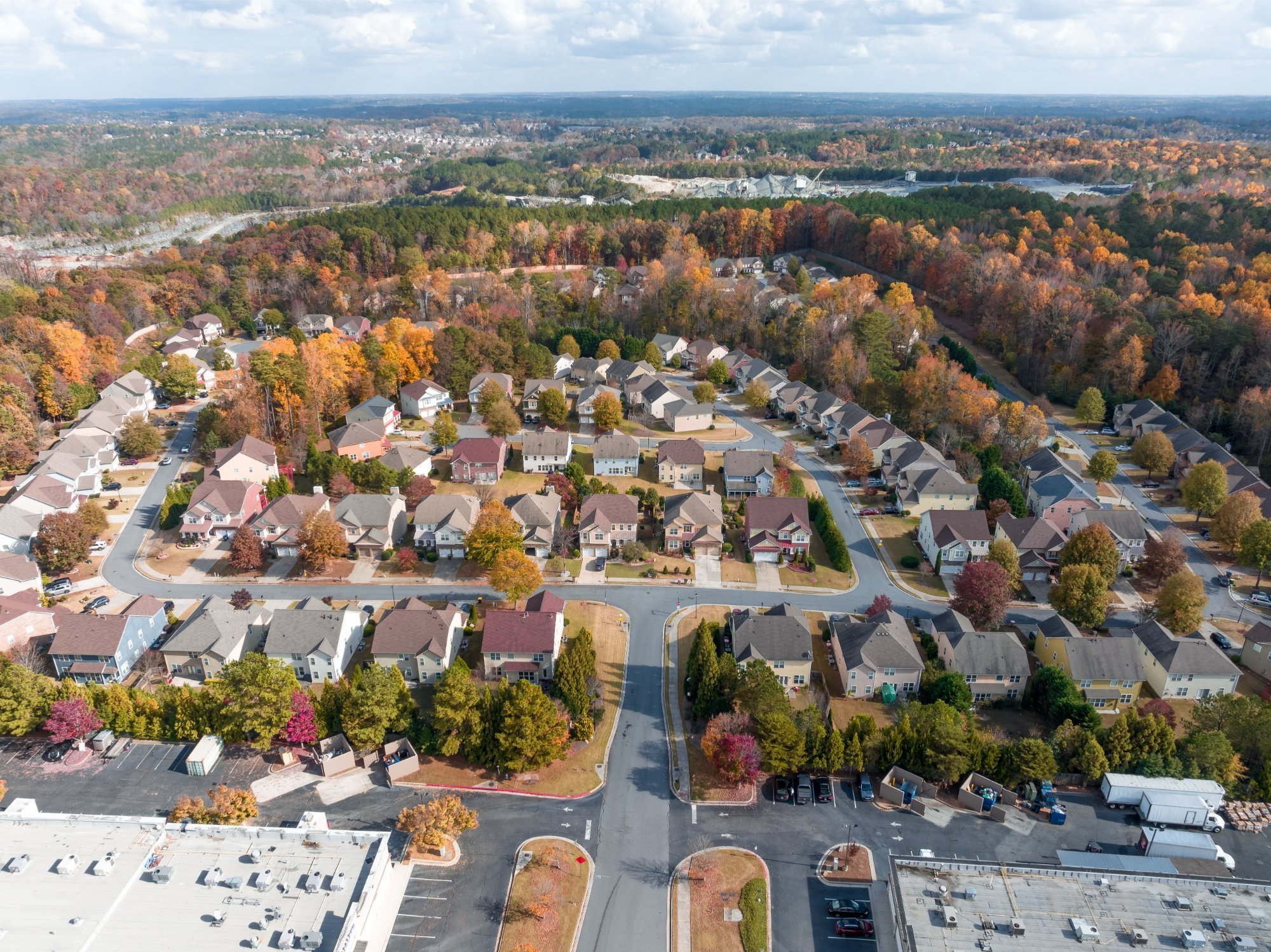Remember when fall meant pumpkin spice and cozy sweaters? Well, for North Carolina's real estate market in 2025, October might just be the new spring. The crisp autumn air brings a fresh perspective on buying and selling homes, challenging the old notion that spring is the only prime time for real estate. This article digs into why fall 2025 could be your golden opportunity in North Carolina's housing market. We'll compare October's market trends with the traditional spring rush, looking at interest rates, available homes, and how many people are house hunting. You'll get the inside scoop on current local data, helping you figure out if it's smart to make a move this fall. Whether you're thinking of selling your family home or searching for your dream house, understanding these fall market perks could give you an edge. So, grab a warm drink, settle in, and let's explore why October 2025 might be the perfect time to buy or sell in North Carolina. Ready to see how the changing leaves could signal a change in your real estate fortunes?
Why October Offers a Unique Market Opportunity
North Carolina's fall real estate dynamics create a sweet spot where neither buyers nor sellers hold all the cards. The market moves at a gentler pace, with properties staying two weeks longer on market compared to busier seasons. This natural slowdown gives everyone breathing room to make thoughtful decisions without the rushed atmosphere of peak seasons.
The market settles into a natural rhythm where both parties find their footing. Sellers benefit from serious buyers who brave the autumn chill to view properties, while house hunters enjoy "31% lower" competition levels than peak season. This reduction in pressure means meaningful conversations about offers and contingencies can take place without the frantic bidding wars common in warmer months.
Property values maintain stability during this period, creating a foundation for fair negotiations. Mid-October brings "16% more newly listed homes" to the market, giving buyers fresh options to consider. These autumn additions often come from motivated sellers who have carefully prepared their homes for sale, resulting in well-maintained properties at realistic price points. About "5.5% of homes" see price adjustments during this time, opening doors for buyers to find value while sellers still secure fair returns.
Moving through neighborhoods during open houses becomes a more relaxed experience in October. The reduced foot traffic means real estate agents can spend quality time with each potential buyer, answering questions thoroughly and highlighting property features properly. Buyers walk through homes at their own pace, taking in details they might miss during crowded spring showings. Mortgage lenders process applications more efficiently, and home inspectors schedule visits more quickly, streamlining the entire purchase process.
Interest Rates and Their Impact
The Federal Reserve's monetary policies have sparked notable shifts in North Carolina's mortgage landscape. Financial analysts report that "higher interest rates increase monthly payments", creating ripple effects throughout the state's housing sector. These adjustments have reshaped how both buyers and sellers approach property transactions during the fall season.
Current Interest Rates in October 2025
North Carolina's mortgage market shows fixed-rate loans averaging 6.36% APR for 30-year terms, while 15-year options sit at 5.57%. These figures represent a 13-basis-point increase from previous periods, prompting careful consideration from potential homebuyers. The 5-year adjustable-rate mortgages clock in at 6.82%, offering an alternative for buyers seeking different financing structures.
Expectations for Rate Trends
Economic forecasts suggest moderate rate fluctuations through the remainder of 2025. Monthly payment calculations demonstrate that even small percentage changes significantly affect long-term costs. Mortgage experts emphasize that rate movements of just a quarter point can alter monthly obligations by hundreds of dollars. This reality makes October's relatively stable rate environment particularly noteworthy for prospective buyers.
Impact on Buying Power and Selling Strategies
Current rate conditions directly influence property affordability and market dynamics. Buyers find their purchasing power affected by each rate adjustment, with higher rates reducing maximum affordable home prices. Sellers have responded by adjusting their pricing strategies and offering creative incentives to maintain buyer interest. Some homeowners provide seller contributions toward closing costs or temporary rate buydowns to offset the impact of higher borrowing costs.
Making strategic moves in this rate environment requires understanding both immediate and long-term implications. Buyers who secure properties during October's moderate rate period position themselves ahead of potential future increases. Meanwhile, sellers who price their homes according to current rate realities find success in attracting qualified buyers despite tighter lending conditions.
Inventory and Buyer Competition
North Carolina's property market shows "4.48 months of inventory" available, creating distinct opportunities across different regions. The state ranks "fourth nationally for homes under construction", demonstrating substantial growth in residential development. This shift marks a notable change from previous years, giving both buyers and sellers fresh perspectives on timing their market moves.
Increase in Home Listings and Inventory
Property listings jumped "10.5%" compared to last year, adding more than 5,000 homes to the available selection. New construction permits reached "4.7 per 1,000 existing homes", surpassing national averages and expanding options for prospective buyers. Local builders have responded to population growth by accelerating development schedules, particularly in suburban areas where land availability meets growing demand.
Faster Turnover in Metro Areas
Raleigh stands out as "one of the fastest-growing metro" regions, with properties moving quickly from listing to closing. The median sales price reached "$366,900" in October 2024, reflecting steady appreciation without the dramatic spikes seen in previous seasons. Urban areas benefit from concentrated buyer interest, leading to efficient market cycles where properly priced homes find new owners within weeks.
Regional Advantages for Buyers and Sellers
Coastal communities maintain steady appreciation rates while mountain regions see seasonal fluctuations that benefit strategic timing. The Triangle area combines strong job markets with educational institutions, drawing consistent buyer interest throughout fall months. Smaller cities offer affordability advantages, with home values stretching further than in major metropolitan centers.
Monitoring local market indicators helps identify prime opportunities in specific neighborhoods. Sellers who price according to recent comparable sales typically secure offers within their target range. Buyers find increased negotiating room during October, especially in areas where new construction adds to existing inventory. Strategic timing during fall months often results in mutually beneficial transactions where both parties achieve their goals.
Pricing Trends and Negotiation Insights
North Carolina's median home value reached $374,994 in 2025, marking a modest 2.1% uptick from previous figures. The gentle rise signals a departure from the rapid appreciation seen in past years, creating room for meaningful discussions between buyers and sellers. Raleigh's neighborhoods show particular stability, with prices holding steady through seasonal changes.
The relationship between listing and final sale prices tells an important story about market dynamics. Properties now sell at 97% of their original asking price, down from the 102% peak during the seller's market frenzy. This shift means buyers no longer face the pressure to bid above asking price, while sellers maintain reasonable returns on their investments. The "housing supply has grown to 5.7 months," establishing a balanced environment where neither party holds excessive leverage.
Smart negotiation strategies have emerged in this evolving landscape. Buyers successfully request repairs after inspections without fear of losing their chance at purchase. Meanwhile, sellers find success offering flexible closing dates or including appliance packages to attract serious offers. The data shows "active listings have increased 25.7%" year-over-year, giving both parties more options to find common ground during negotiations.
Reduced competition has transformed fall transactions into thoughtful discussions rather than rushed decisions. Buyers now schedule second viewings without competing offers hanging over their heads. Sellers receive fewer but more qualified offers, leading to smoother closings. Recent market shifts reveal that properties typically need two price adjustments before finding the sweet spot where buyers and sellers agree, creating genuine opportunities for both sides to achieve their goals.
Regional Variations in North Carolina
The median sale price of $390,200 paints a drastically different picture across North Carolina's diverse neighborhoods. Mountain communities maintain steady property values throughout October, while coastal areas show distinct seasonal patterns. Smaller towns nestled between major cities benefit from spillover growth, creating unique opportunities for both buyers and sellers during autumn months.
Urban Trends
Raleigh's tech corridor continues drawing young professionals, pushing property demand beyond traditional boundaries. The capital city's suburbs show particular strength, with homes staying on market for 53 days - a significant shift from previous seasons. Charlotte's banking district propels surrounding neighborhood growth, particularly in areas with direct light rail access. New developments near these transit hubs command premium prices while established neighborhoods maintain steady appreciation.
Rural and Smaller Towns
Farm communities and historic districts present compelling alternatives to metropolitan living. Local economies built around agriculture, manufacturing, and tourism support stable housing markets less affected by seasonal swings. Properties in these areas often include larger lots and additional structures, appealing to buyers seeking more space for their investment. Small town charm combines with modern amenities as fiber internet and remote work options make rural living increasingly practical.
Analyzing 67,054 homes currently listed reveals stark contrasts between zip codes. Downtown condos in major cities move quickly despite premium pricing, while countryside properties require targeted marketing to reach qualified buyers. Mountain view properties near Asheville maintain their appeal through fall, benefiting from leaf-watching tourism. Coastal communities from Wilmington to the Outer Banks adjust to seasonal rhythms, with October presenting opportunities for value-conscious buyers.
Moving goods between distribution centers drives growth along major highway corridors. Towns positioned near interstate exchanges see steady demand from logistics workers and supporting businesses. University communities maintain their own market cycles, influenced more by academic calendars than traditional seasonal patterns. Local manufacturing hubs create stable employment bases, supporting consistent housing demand regardless of season.
Expert Advice for Buyers and Sellers
North Carolina real estate veterans have noticed a significant shift in fall market dynamics, with October 2025 presenting unique opportunities for decisive action. Local professionals with decades of experience point to changing buyer behaviors and seller expectations, creating fresh possibilities for both sides of the transaction table. Their collected wisdom offers practical steps for navigating this evolving marketplace.
- Getting pre-approved for mortgages before house hunting saves valuable time when multiple buyers eye the same property. Mortgage specialists recommend gathering tax returns, bank statements, and employment verification ahead of time. This preparation typically cuts approval time from three weeks to just five days.
- Scheduling home inspections during the first week after acceptance prevents last-minute surprises. Professional inspectors report fewer scheduling conflicts during October, often accommodating next-day appointments. Quick inspections allow buyers to address concerns while maintaining momentum toward closing.
- Sellers who complete minor repairs before listing often net $7,200 more at closing. Fresh caulk around windows, updated light fixtures, and professional carpet cleaning make immediate impressions on buyers. These improvements typically cost under $1,500 but significantly reduce negotiation points.
- Working with contractors to obtain repair estimates before listing helps sellers set realistic prices. October's slower pace gives professionals time to provide detailed quotes, preventing costly surprises during buyer negotiations. Having these numbers ready streamlines the entire transaction process.
- Studying recent sales within a half-mile radius provides the most accurate pricing guidance. Properties sold within 60 days offer the clearest picture of current market values. This focused research prevents the common mistake of using outdated comparisons from different neighborhoods.
Setting fair market prices requires careful analysis of neighborhood-specific data. Properties priced within 3% of actual market value typically sell within 28 days, while overpriced homes linger for months. Professional appraisers suggest reviewing both pending and closed sales to capture current market momentum. Factoring in seasonal adjustments helps both buyers and sellers understand realistic property values during October's unique market conditions.
Practical Recommendations for Success
Seasoned homebuyers from previous fall markets discovered that October brings distinct advantages when handled strategically. The cooling temperatures mirror a calmer purchasing environment, where decisions flow naturally without the pressure of spring bidding wars. North Carolina's autumn real estate scene rewards methodical planning over rushed choices.
Buyer's Action Plan
Start with a detailed property wishlist focused on specific neighborhoods rather than broad city searches. Research school districts, commute times, and local amenities before viewing homes. Schedule viewings between 10 AM and 2 PM to see properties in natural daylight, revealing true colors and potential maintenance needs.
Create a dedicated folder for each viewed property containing inspection reports, utility costs, and property tax history. Track price adjustments on favorite listings using real estate apps, noting homes that have been listed for more than 45 days. These properties often present the best negotiation opportunities during October.
Smart Selling Tactics
Schedule professional photos when fall foliage reaches peak colors, typically mid-October in North Carolina. Clean gutters and rake leaves daily during showing periods to maintain curb appeal. Consider hosting open houses on sunny weekend afternoons when natural light fills living spaces.
Price properties based on August and September sales data, adjusting for seasonal market shifts. Highlight energy-efficient features and recent weatherization improvements that appeal to cost-conscious buyers. Organize maintenance records chronologically, demonstrating consistent care throughout your ownership.
Market Intelligence Tools
Download neighborhood-specific market reports from local real estate associations. Set up price alerts for comparable properties within a three-mile radius. Join community social media groups to gauge local market sentiment and upcoming development plans.
Monitor mortgage rate trends through financial news websites, understanding how rate changes affect monthly payments. Research property tax assessment schedules and appeal deadlines. Familiarize yourself with local zoning regulations and future infrastructure projects that might impact property values.
Creating a dedicated spreadsheet helps track viewing schedules, follow-up tasks, and important deadlines. Document all communication with agents, lenders, and other parties involved in the transaction. Keep digital copies of all paperwork organized in cloud storage for easy access during negotiations.
Final Thoughts
October 2025 brings unique opportunities for North Carolina's real estate market. The fall season offers less competition among buyers, more reasonable prices, and motivated sellers who want to close before year's end. While spring traditionally gets attention as the prime real estate season, October provides practical advantages for both buyers and sellers in North Carolina.
The data shows lower interest rates and a good balance of inventory, making fall 2025 a smart time to act. Buyers can take their time viewing properties without the rushed feeling of spring bidding wars. Sellers benefit from serious buyers who brave the cooler weather to house hunt. The reduced competition means both parties can negotiate more effectively.
The North Carolina market has its own rhythm, different from national trends. What works in other states might not apply here. That's why understanding local market timing matters so much. Whether you're buying your first home or selling to upgrade, October 2025 offers a sweet spot of opportunity.
Don't wait for the spring rush if you're ready to make a move. Talk to a local real estate agent now about your plans. They can help you understand neighborhood-specific trends and pricing. The right time to buy or sell isn't just about the season - it's about when the conditions match your needs. For many North Carolina residents, October 2025 might be that time.








